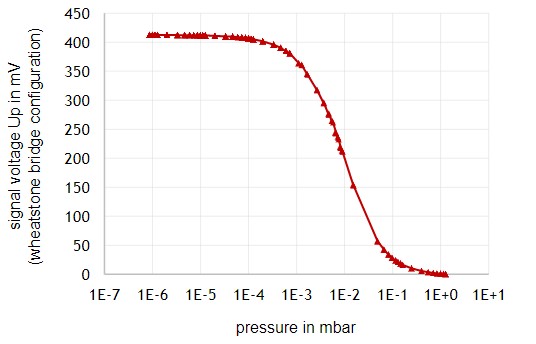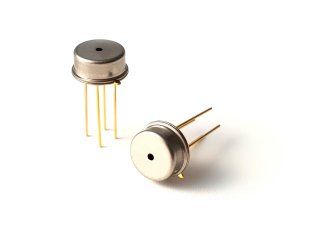Vacuum Sensing
Vacuum Sensing
Besides thermopiles, Heimann Sensor also offers solutions for vacuum sensing for wide pressure ranges. These are MEMS type pirani vacuum sensors
Pirani Measurement Principle
The measurement principle of a pirani vacuum gauge is rather simple. A metal wire is heated by an electric current. If the wire is in a perfect vacuum, there is no gas and therefore no heat loss. In real conditions (not perfect vacuum) the surrounding gas will remove heat/energy from the wire. The amount of removed heat is related to the number of gas molecules and therefore to the pressure.
There are three possible operation modes for a pirani vacuum gauge:
- Constant current
- Constant voltage
- Constant temperature
The most basic operation mode is constant current operation. In this case the sensor (which is basically a resistance) is supplied by a constant current. In this case the resistance which is related to the temperature of the sensor is measured and gives you the information about the pressure. In real application this mode is almost never used.
More common are the two other operation modes. In constant voltage mode (U0 = const.), the sensor is applied in a wheatstone bridge configuration:

Rp is the pressure sensitive resistance and Rk is the compensation resistance which is placed also on the sensor chip. Rfixed and R are used to complete the wheatstone bridge arrangement. For constant voltage mode the bride should be balanced (Up = 0V) at atmospheric pressure. This is done by tuning the potentiometer R. If the pressure is changing, Rp will change and therefore Up will change too. The constant voltage operation mode is recommended for high vacuum measurements and low power operation, but requires a temperature stabilization or advanced calibration for accurate measurements.
The constant temperature mode, also called constant resistance mode, is commonly used, because it can reduce unwanted signal drift caused by changing ambient temperature. This is best suited for rough and fine vacuum conditions. In this case an operational amplifier is used to control the resistance ratio of Rk and Rp and therefore keeps them at a constant temperature difference.
Pirani Gauge Characteristic Curve
The picture below shows a typical characteristic curve of a pirani type vacuum gauge in the wheatstone bridge configuration (constant voltage mode). It shows the signal voltage Up vs. the pressure in mbar. As you can see the sensor can go down to 10-6 mbar, but the slope of the curve is very low. This means sensitivity is also very low in this range. In the range from 10-1 to 10-3 mbar the sensor has a steep slope and therefore its highest sensitivity.

The above curve shows the sensitivity of a relatively large chip (HVS 03k) with 4x4mm² chip size. You can combine this with a second, smaller chip with 1x1mm² which has its peak sensitivity in higher pressure regimes. This combination of two chips allows to sense the whole pressure range from atmospheric pressure down to 10 -6 mbar.

